Banknotes of the Japanese yen
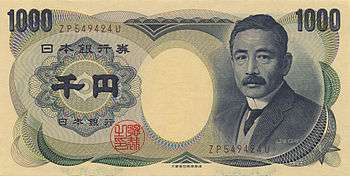
The banknotes of the Japanese yen are part of the physical form of Japan's currency. The issuance of the yen banknotes began in 1872, two years after the currency was introduced. Throughout its history, the denominations have ranged from 0.05 yen to 10,000 yen.
Before World War II
In 1869, the Ministry of Finance introduced notes in denominations between 10 sen and 100 yen. "Imperial Japanese Paper Currency" followed in 1873 in denominations of 1 yen up to 20 yen. "Imperial Japanese Paper Money" was issued between 1881 and 1883 in denominations between 20 sen and 10 yen.
In 1877 and 1878, the Imperial Japanese National Bank issued 1 and 5 yen notes. In 1885, the Bank of Japan began issuing notes, in denominations of 1, 5, 10 and 100 yen. 20 yen notes were added in 1917, followed by 200 yen in 1927 and 1000 yen in 1945. [1]
Between 1917 and 1922, the government issued 10, 20 and 50 sen notes. 50 sen notes were reintroduced in 1938. In 1944, 5 and 10 sen notes were introduced by the Bank of Japan.
Allied forces notes
The Allies issued notes in denominations of 10 and 50 sen, 1, 5, 10, 20, 100 and 1000 yen between 1945 and 1951, during which time the Bank of Japan also issued notes. Banknotes below 1 yen became invalid on December 31, 1953 under the Small Currency Disposition and Fractional Rounding in Payments Act.
Australia actually made notes for the occupation as well and those can be seen at the Australian Reserve Bank website [2]
Post occupation
By the early 1950s, notes below 50 yen had been replaced by coins, followed by those for 50 and 100 yen in the late 1950s. In 1957 and 1958, 5000 and 10,000 yen notes were introduced. The 500 yen notes were replaced after 1982, while 2000 yen notes were introduced in 2000.
1946-48
| Series A (1946–48) | ||||||||
|---|---|---|---|---|---|---|---|---|
| Image | Value | Dimensions | Description | Date of | ||||
| Obverse | Reverse | Obverse | Reverse | Issue | Issue suspension | Expiration | ||
| ¥0.05 | 94 × 48 mm | Prunus mume blossoms | Geometric patterns | May 25, 1948 | December 31, 1953 | June 30, 1954 | ||
| ¥0.1 | 100 × 52 mm | Pigeons | The Diet building | September 5, 1947 | ||||
| ¥1 | 124 × 68 mm | Ninomiya Sontoku | Geometric patterns | March 19, 1946 | October 1, 1958 | Valid | ||
| ¥5 | 132 × 68 mm | Geometric patterns | March 5, 1946 | April 1, 1955 | ||||
 |
 |
¥10 | 140 × 76 mm | The Diet building | February 25, 1946 | |||
 |
 |
¥100 | 162 × 93 mm | Prince Shōtoku, "Yumedono" (A hall associated with Prince Shōtoku in Hōryū-ji Temple) | Hōryū-ji Temple | February 25, 1946 | July 5, 1956 | |
| For table standards, see the banknote specification table. | ||||||||
1950-53
| Series B (1950–53) [3] | ||||||||
|---|---|---|---|---|---|---|---|---|
| Image | Value | Dimensions | Main Color | Description | Date of | |||
| Obverse | Reverse | Obverse | Reverse | Issue | Issue suspension | |||
| ¥50 | 144 × 68 mm | Orange | Takahashi Korekiyo | The headquarters of the Bank of Japan | December 1, 1951 | October 1, 1958 | ||
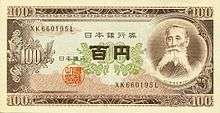 |
 |
¥100 | 148 × 76 mm | Brown-orange | Itagaki Taisuke | The Diet building | December 1, 1953 | August 1, 1974 |
 |
 |
¥500 | 156 × 76 mm | Dark blue | Iwakura Tomomi | Mt. Fuji | April 2, 1951 | January 4, 1971 |
 |
 |
¥1000 | 164 × 76 mm | Grey | Prince Shōtoku | "Yumedono" | January 7, 1950 | January 4, 1965 |
| For table standards, see the banknote specification table. | ||||||||
The series B introduced a new high value banknote ¥1000.
1957-69
| Series C (1957–69) [3] | ||||||||
|---|---|---|---|---|---|---|---|---|
| Image | Value | Dimensions | Main Color | Description | Date of | |||
| Obverse | Reverse | Obverse | Reverse | Issue | Issue suspension | |||
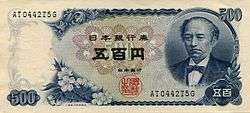 |
 |
¥500 | 159 × 72 mm | Blue | Iwakura Tomomi | Mt. Fuji | November 1, 1969 | April 1, 1994 |
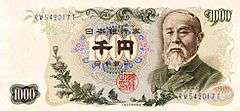 |
 |
¥1000 | 164 × 76 mm | Yellow-green | Itō Hirobumi | The headquarters of the Bank of Japan | November 1, 1963 | January 4, 1986 |
 |
 |
¥5000 | 169 × 80 mm | Green-brown | Prince Shōtoku | The headquarters of the Bank of Japan | October 1, 1957 | January 4, 1986 |
_front.jpg) |
_back.jpg) |
¥10,000 | 174 × 84 mm | Brown-green | Prince Shōtoku | A pillar painting of Hōō in Byōdō-in Temple | December 1, 1958 | January 4, 1986 |
| For table standards, see the banknote specification table. | ||||||||
The series C introduced two new high value banknotes ¥5000 and ¥10,000.
1984
| Series D (1984) [4] | ||||||||
|---|---|---|---|---|---|---|---|---|
| Image | Value | Dimensions | Main Color | Description | Date of | |||
| Obverse | Reverse | Obverse | Reverse | Issue | Issue suspension | |||
 |
 |
¥1000 | 150 × 76 mm | Blue | Natsume Sōseki | Pair of cranes | November 1, 1984 | April 2, 2007 |
 |
 |
¥5000 | 155 × 76 mm | Purple | Nitobe Inazō | Mt. Fuji, Lake Motosu and cherry blossoms | ||
 |
 |
¥10,000 | 160 × 76 mm | Brown | Fukuzawa Yukichi | Pair of pheasants | ||
| For table standards, see the banknote specification table. | ||||||||
Due to the discovery of a large number of counterfeit Series D banknotes at the end of 2004, all Series D banknotes except ¥2000 were virtually suspended on January 17, 2005,[5] and officially suspended on April 2, 2007.[6] According to a news release [7] from the National Police Agency, they seized 11,717 counterfeit Series D banknotes (excluding the ¥2000 denomination) in 2005. However, they seized only 486 counterfeit current issue banknotes, namely Series E ¥1000, ¥5000, ¥10,000, and Series D ¥2000.
2000
| Series D (2000) [4] | |||||||
|---|---|---|---|---|---|---|---|
| Image | Value | Dimensions | Main Color | Description | Date of issue | ||
| Obverse | Reverse | Obverse | Reverse | ||||
_front.jpg) |
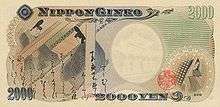 |
¥2000 | 154 × 76 mm | Green | Shurei-mon | Scene from the Tale of Genji and portrait of Murasaki Shikibu | July 19, 2000 |
| For table standards, see the banknote specification table. | |||||||

This is the current issue. The 2000 yen note was first issued on July 19, 2000 to commemorate the 26th G8 summit in Okinawa and the 2000 millennium year as well. Pictured on the front of the note is Shureimon, a famous gate in Naha, Okinawa near the site of the summit. The other side features a scene from The Tale of Genji and the author Murasaki Shikibu on the lower right corner. The motif of the scene was taken from the 12th century illuminated handscrolls of the novel kept at the Tokugawa Art Museum in Nagoya. The image of Murasaki Shikibu is taken from the Gotoh edition of the Murasaki Shikibu Diary Emaki held at the Gotoh Museum.
These notes are rare in the market, but at banks they are readily available. Many Japanese consider the 2000 yen note a novelty as it is the only Japanese denomination whose first digit is 2. To promote the circulation of the notes, some companies had started paying wages in them. The series D is the first to display the EURion constellation.
2004
| Series E (2004) [4] | |||||||
|---|---|---|---|---|---|---|---|
| Image | Value | Dimensions | Main Color | Description | Date of issue | ||
| Obverse | Reverse | Obverse | Reverse | ||||
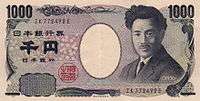 |
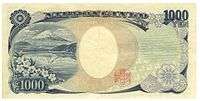 |
¥1000 | 150 × 76 mm | Blue | Noguchi Hideyo | Mt. Fuji, Lake Motosu and cherry blossoms | November 1, 2004 |
 |
 |
¥5000 | 156 × 76 mm | Purple | Higuchi Ichiyō | Kakitsubata-zu (Painting of irises, a work by Ogata Kōrin) | |
 |
 |
¥10,000 | 160 × 76 mm | Brown | Fukuzawa Yukichi | Statue of hōō (phoenix) from Byōdō-in Temple | |
| For table standards, see the banknote specification table. | |||||||
This is the current issue. The EURion constellation pattern can be observed on the series E.
References
- ↑ "1000 Yen note 1945 prince Yamato Takeru". World Banknotes. Retrieved 14 February 2015.
- ↑ "Archived copy". Archived from the original on 2007-09-03. Retrieved 2007-09-04.
- 1 2 "Archived copy" (PDF). Archived from the original (PDF) on 2009-03-25. Retrieved 2008-04-27.
- 1 2 3 Currency in Use: Bank of Japan Archived 2007-08-18 at the Wayback Machine.
- ↑ http://www.boj.or.jp/type/release/zuiji/bnnew16.htm Archived August 8, 2007, at the Wayback Machine.
- ↑ 一万円券、五千円券および千円券の今後の支払について:日本銀行 Archived September 29, 2007, at the Wayback Machine.
- ↑ http://www.npa.go.jp/toukei/souni/gizou.htm Archived August 10, 2007, at the Wayback Machine.
External links
| Wikimedia Commons has media related to Money of Japan. |
